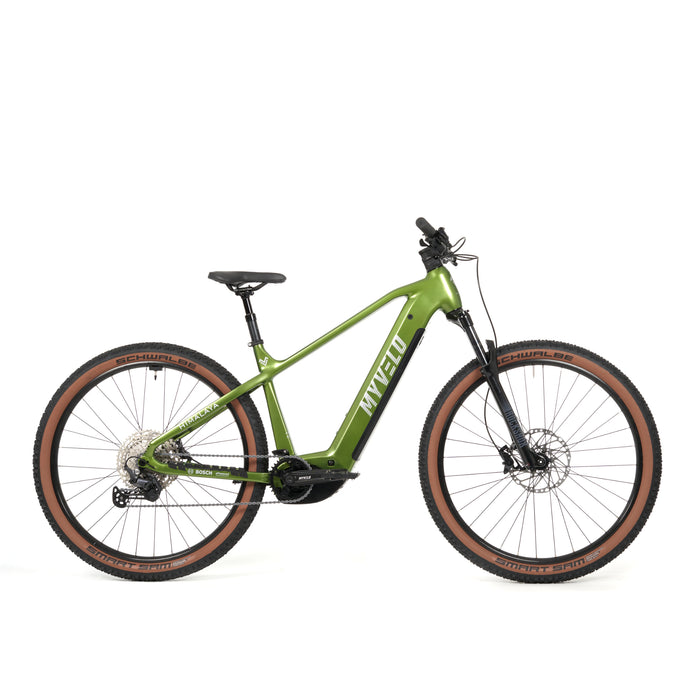
Himalaya E-MTB
incl. FREE shipping & free returns
📣 Only for a short time 200€ savings
📦 Delivery end of August

A shift cable is a central component of a bicycle's gear system. It mechanically transmits the movement from the shift lever to the front or rear derailleur, ensuring that the chain shifts precisely between gears.
A shift cable consists of two main components:
inner cable
A thin, flexible steel cable (similar to Bowden cables).
It runs inside the outer shell.
Is tightened or loosened when shifting and thus moves the rear derailleur.
Outer shell
Protects the inner cable from dirt, water and damage.
Made of plastic with a metal spiral or reinforcement inside.
Often provided with a sliding coating on the inside so that the inner cable runs with as little friction as possible.
When the shift lever is operated, the inner cable pulls or relaxes.
This moves the rear derailleur or front derailleur.
This ensures that the chain switches to a different sprocket or chainring.
If gear shifting is difficult, imprecise or delayed.
If there are visible rust spots or fraying on the cable.
After a fall in which the rear derailleur or shift lever was damaged.
Regularly for intensive use, e.g., for sports or everyday bikes every 1-2 years.
A shift cable is different from a brake cable, although they look similar. Both transmit pulling power, but shift cables are finer and more flexible, as they are responsible for precise movements — not large braking forces.
The shift cable is an inconspicuous but extremely important part of the groupset. Without it, nothing would work in mechanical shifting systems – it's the "connecting cable" between your finger and the movement of the chain.

Entdecke den MYVELO
Entdecke Dein Traum E-Bike im MYVELO Onlineshop. Direkt vom Hersteller Dein Fahrrad aussuchen.

Dein Traumrad
MYVELO hat bereits 2 Standorte: Oberkirch & Geretsried. Komm in unsere Flagship Stores und probiere Dein Traum Bike aus. Lass Dich von uns zu Deinen Anforderungen beraten.

Leasen statt kaufen
Spare mit Leasing! Finanziere Dein Traum E-Bike ganz einfach über Deinen Arbeitgeber. MYVELO unterstützt Dich im Leasing-Prozess bei Deinen Fragen.

Wer sich den Traum vom hochwertigen E-Bike erfüllen möchte, steht oft vor einer großen Investition. Doch immer mehr Menschen entdecken eine clevere Alternative zum Kauf: das Fahrrad privat leasen. Was bisher vor allem im Jobrad-Modell über Arbeitgeber bekannt war, funktioniert heute auch für Privatpersonen – flexibel, günstig und steuerlich oft vorteilhaft.

Wer mit dem Fahrrad oder E-Bike unterwegs ist, weiß: Die richtige Schalttechnik macht den Unterschied zwischen einem flüssigen, energiesparenden Fahrstil und unnötiger Anstrengung. Doch viele Radfahrerinnen und Radfahrer nutzen ihre Gangschaltung nicht optimal – sei es aus Unsicherheit oder Gewohnheit. In diesem Artikel erfährst Du, wie man richtig schaltet, worauf man bei E-Bikes mit Kettenschaltung oder Nabenschaltung achten sollte und welche Fehler man vermeiden kann.

Das Hollandrad ist längst mehr als nur ein Klassiker aus den Grachtenstädten der Niederlande – es ist ein Sinnbild für entspanntes Radfahren, Komfort und zeitloses Design. In deutschen Städten erlebt das Hollandrad derzeit ein echtes Comeback, nicht zuletzt, weil es den urbanen Lifestyle perfekt widerspiegelt. Doch worin unterscheidet sich ein Hollandrad eigentlich von einem Citybike – und welche Rolle spielen moderne E-Bike-Versionen?